
Fractures Page Menu: 1 2 3 4 5 6 7 8 9 10 11 12 Next>>
Fracture Treatment During the Golden Age of Piracy, Page 8
Maintaining the Bone's Position: Enclosing the Fractured Limb
Similar to splints are enclosures. These were devices designed to keep the wounded part from moving around while the patient was healing.
Hippocrates discusses open-topped channels at length (revering to them as canals), although he definitely has mixed feelings about using them. He explains that while channels can be useful, many surgeons expect too much from them.
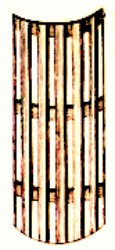
Wooden Fracture Cradle
From Alle De Medinale
en Chirurgicale,
by Solingen Cornelius
(1698)
For the canals do not preserve the leg at rest, as they [those who use canals] suppose; nor, when the rest of the body is turned to the one side or the other. And a board [canals apparently being made from wood at the time he wrote] is an uncomfortable thing to have the limb laid upon, unless something soft be placed above it. But it is a very useful thing in making any subsequent arrangements of the bed and in going to stool. A limb then may be well or ill arranged with or without the canal. But the common people have more confidence, and the surgeon is more likely to escape blame, when the canal is placed under the limb, although it is not secundum
artem [according to art - ie. not typically suggested by surgical practitioners]."1
In the case of a fractured thigh bone, Hippocrates felt canals were of little use when didn't go below the lower part of the leg. He explains that "it neither prevents the body nor the leg from being moved without the thigh" since a short canal doesn't prevent bending of the knee. For, "if one bend[s] the limb at the knee, the muscles [or the thigh] necessarily assume another shape, and the broken bones are also necessarily moved." He goes on to advise "that a canal which embraces the limb from the nates [buttocks] to the foot is of use."2
Rather than just employing open-topped channels, period and near-period surgeons relied on two methods of arresting the movement of the limb. The first is by tying soft padding to either side of the fractured limb such as rolled cloth or juncts (fabric bags filled with relatively stiff grasses or reeds). The second is by using a 'case' or 'box' - basically a channel with a lid.

Photo: Franz Xaver
Grass-Like Juncaceae - Juncus Effusus
We have already seen the use of juncts in the section on splint properties, where John Woodall suggested "that they may defend it [the fracture] in bed from wrong, and they are gently to bee bound to the member, that they may turne with it if occasion be"3. In a case study, military surgeon William Clowes reveals how he "laid or placed the member as seemly and decently as possibly might be in a double linen towel rolled up at both ends, with a good quantity of long rushes [stiff, grass-like plants more formally called Juncaceae - possibly the origin of the name 'junct'] ....and I did make thereof as it were a bed to lay or place the fractured member in, so that he could by no means any way move his fractured leg, but safely and quietly he rested"4.
Sea surgeon John Moyle also uses them when dressing a patient's fractured leg, telling the surgeon to let "two long Junks [juncts] be placed on it, one on either side, and fasten'd at the Knee, and likewise to the Foot; and so let the Leg be plac'd on a Pillow, and let the hollow places be made even with the rest, with Tow, and all to keep the limb steady."7
In
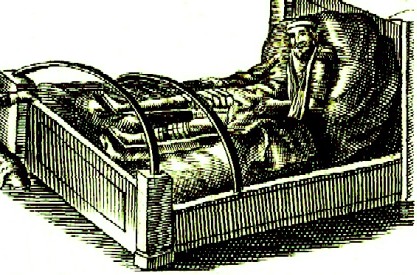
Open Cases with Pillows for the Legs and an Arm, From The
Chyrurgeons Storehouse, by Johannes Scultetus, p. 68 (1653)
the same case, Moyle advises that when the surgeon is dressing a fractured arm, "let a Case of Tin, with a small Pillow in it, be plac'd to the Breast for the Arm to rest in."8 In his book for sea surgeons, John Moyle explains that you can use "Juncts to keep it steady, if you have not a Case."9 Moyle elsewhere suggests that "a Case with a Pillow in it ...be provided for the Limb, to keep it steady."10 German surgeon Matthias Gottfried Purmann concurs, suggesting that the last step of his procedure is to "lay the Dressed Member in a Case, or on a Leather Cushion made for that purpose"11.
The above three quotes suggest that a case may be preferred because it may better keep the fractured part from unwanted movement. As Purmann explains, patients create problems by "loosening the Bandages, leaving their Beds too soon, or using their Limbs before the Calus is confirm’d, and [is] strong enough to endure the Weight of the Body, and from hence comes weak, crooked, and contracted Members."12 A case would help to prevent the patient from moving around and causing such problems.
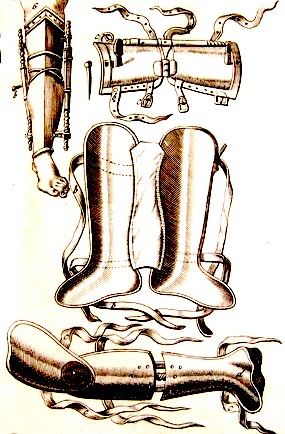
Various Metal Fracture Cases,
From Alle
De Medinale
en Chirurgicale,
by
Solingen Cornelius. Table 12
(1698)
Ambroise Paré provides further insight into the makeup and use of a case, rather poetically explaining them.
Cases are made of plates of latin [latten - probably sheets of tin. Possibly also referring to white latten - tin-plated iron], or else some light wood; their use is to contain the bones in their due figure, when the Patient is to be carried out of one bed or chamber into another, or else has need to go to stool; lastly, if we must rest somewhat more strongly upon the broken or luxated [dislocated] members, these Cases will hinder the bones from stirring or flying out on the right side or left, above or below, we sleeping or waking, being willing or unwilling; and in like sort left being not as yet well knew, or more loosely bound up for fear of pain, inflammation, or a gangrene, they hang downe, fall, or fly in sunder by reason of the inequalities of the bed.13
Although Paré's book was still in print around the time of the golden age of piracy, he was writing a century before it; materials and methods for manufacture of cases had improved over time. For example, Moyle recommends a
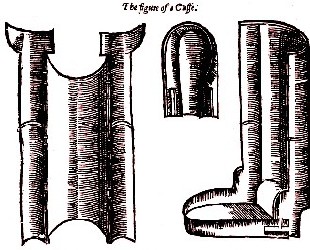
The Parts of a Case, from The Workes
of That
Famous
Chirurgeon Ambroise Parey,
by
Ambroise Paré, p. 376 (1649)
modified case for compound wounds; John Keevil details how Moyle "'contrived a Case of Tin to contain the Leg, in which were two little doors to open and shut, for the opportunity of making applications to the wounded parts'"14. Physician Hugh Ryder created a similar contraption while at sea, when Sir Thomas Allen, Admiral in the Royal James, sustained (among other wounds) a compound leg fracture. Ryder "placed it on a pillow in a box, or case with hinges, to turn down, to come at and dress the wounded places, which I had at convenient interstices left open for that purpose"15.
The progression in design for enclosures for fractured limbs is most interesting. As can be seen in Paré's drawing from his bok, it was basically formed like a modern cast using more primative materials.
1 Hippocrates, Of Fractures, Hippocratic Writings, Translated by Francis Adams, p. 81-2; 2 Hippocrates, p. 83; 4 John Woodall, the surgions mate, p. 161-2; 3 William Clowes, Selected Writings of William Clowes, p. 128; 5 Ambroise Paré, The Workes of that Famous Chirurgion Ambrose Parey, p.361; 6 Richard Wiseman, Of Wounds, Severall Chirurgicall Treatises, p. 470; 7,8 John Moyle, Memoirs: Of many Extraordinary Cures, p. 290; 9 John Moyle, The Sea Chirurgeon, p. 121; 10 Moyle, Sea Chirurgeon, p. 117; 11 Matthias Gottfried Purmann, Churgia Curiosa, p. 213; 12 Purmann, p. 211-2; 13 Paré, p. 361; 14 John J. Keevil, Medicine and the Navy 1200-1900: Volume II – 1640-1714, p. 168-9; 15 Hugh Ryder, New Practical Observations in Surgery Containing Divers Remarkable Cases and Cures, p. 11
Maintaining the Bone's Position: Slings
Hippocrates comments on the use of slings to hold the patient's arm. He is the only one to specifically do so.
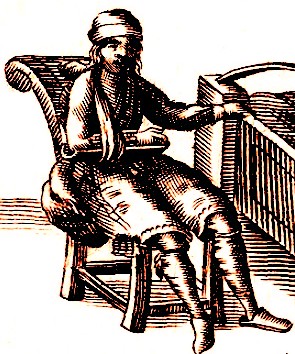
Man With Arm in A Sling, From Armamentarium
Chirurgicum Bipartitum, by Johannes Scultetus,
p. 68 (1666)
Hippocrates begins but explaining that the arm is normally "inclined outward; to the side". Because of this, the "bones are usually distorted during treatment for fracture to that side to which they naturally incline." To remedy this, he suggests the arm "be encircled in a broad shawl, which is to be carried round the breast, and when the patient goes to rest, a compress of many folds, or some such thing, is to be folded and placed between the elbow and the side, for thus the bending of the bone will be rectified"1.
The shawl must be tight at the fracture when one of the two bones in the lower arm are broken or "the bone must necessarily be found to be distorted upwards", causing misaligned healing. When both bones are broken and the entire arm isn't supported, the arm "will be distorted to the lower side. The greater part of the arm and wrist of the hand should therefore be equally suspended in a broad soft shawl."2
1 Hippocrates, Of Fractures, Hippocratic Writings, Translated by Francis Adams, p. 78; 2 Hippocrates,, p. 78
Maintaining the Bone's Position: Crutches
Like slings, crutches are not widely discussed, although they do appear in period and before-period illustrations. (More oftenassociated with beggars rather than fracture victims.) This suggests they were most likely a component in a healing leg fractures once the patient was able to put weight on the fractured member, although they were not necessarily something the surgeon was involved with. The patient probably procured and decided to use them of his own volition.
One of our period surgical writers does mention them, however. While detailing a case of a man with a fractured thigh from 1709, sea surgeon John Atkins explains that after 3 weeks of treatment, his patient "became able to walk about with Crutches, and soon after without."1
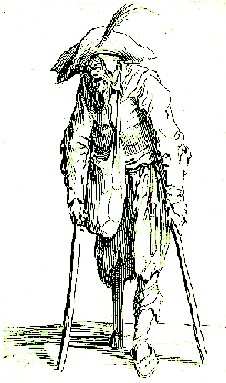 Artist: Jacques Callot Les Geaux, Le Mendiant (1622) |
 Epictetus With His Crutch, From the Frontispiece of Enchiridon (1715) Epictetus With His Crutch, From the Frontispiece of Enchiridon (1715)
|
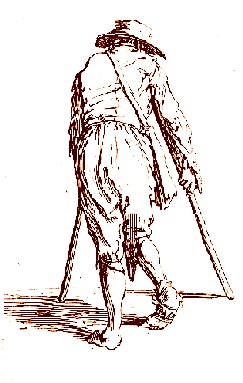 Artist: Jacques Callot Les Geaux, Beggar On Crutches (1621) |
3 John Atkins, The Navy Surgeon, p. 60

